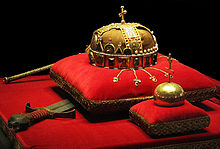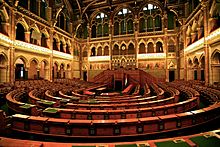
Budapest was united from three cities in 1873, namely Buda, Óbuda, and Pest.[4] Seven years later the Diet resolved to establish a new, representative parliament building, expressing the sovereignty of the nation. The building was planned to face the river. An international competition was held, and Imre Steindl emerged as the victor; the plans of two other competitors were later also realized in the form of the Ethnographic Museum and the Hungarian Ministry of Agriculture, both facing the Parliament Building. Construction from the winning plan was started in 1885, and the building was inaugurated on the 1000th anniversary of the country in 1896. It was completed in 1904. (The architect of the building went blind before its completion.)
About 100 000 people were involved in construction, during which 40 million bricks, half a million precious stones and 40 kilograms (88 lb) of gold were used. Since World War II the legislature became unicameral, and today the government uses only a small portion of the building. During the People's Republic of Hungary a red star perched on the top of the dome, but it was removed in 1990. Mátyás Szűrös declared the Hungarian Republic from the balcony facing Kossuth Lajos Square on 23 October 1989.
Photo By Alex Proimos from Sydney, Australia - Hungarian Chamber, CC BY 2.0, https://commons.wikimedia.org/w/index.php?curid=25649983
This track is a walking the route with an audio guide to Budapest. A full-day trip is a great way to get to know the city and its history. The excursion begins at the Opera building, then through the park goes to the Parliament building. From the parliament building, which is highly recommended to visit, the embankment route passes to the memorial to the victims of the Holocaust. Then we cross the Danube along one of the most recognizable bridges in Europe and the most famous bridge in Budapest - the Széchenyi Bridge. In the part of the city that used to be called Buda, we will climb the hill of the royal castle and find ourselves in the most beautiful places. There are the Fisherman's Bastion, the ancient streets, and towers and at the end of the exploration of this part of the city, we will descend into an underground labyrinth with rock paintings. At the end of the beautiful day, we will visit the museum of the Jewish mystic illusionist Houdini, the most famous funicular in Europe and the zero kilometer of the Hungarian Republic.
The Hungarian Parliament Building (Hungarian: Országház, pronounced [ˈorsaːghaːz], which translates to House of the Country or House of the Nation), also known as the Parliament of Budapest after its location,[1] is the seat of the National Assembly of Hungary, a notable landmark of Hungary and a popular tourist destination in Budapest. It lies in Lajos Kossuth Square, on the bank of the Danube. It is currently the largest building in Hungary[2] and it is still the tallest building in Budapest.[3]
History[edit]
Budapest was united from three cities in 1873, namely Buda, Óbuda, and Pest.[4] Seven years later the Diet resolved to establish a new, representative parliament building, expressing the sovereignty of the nation. The building was planned to face the river. An international competition was held, and Imre Steindl emerged as the victor; the plans of two other competitors were later also realized in the form of the Ethnographic Museum and the Hungarian Ministry of Agriculture, both facing the Parliament Building. Construction from the winning plan was started in 1885, and the building was inaugurated on the 1000th anniversary of the country in 1896. It was completed in 1904. (The architect of the building went blind before its completion.)
About 100 000 people were involved in construction, during which 40 million bricks, half a million precious stones and 40 kilograms (88 lb) of gold were used. Since World War II the legislature became unicameral, and today the government uses only a small portion of the building. During the People's Republic of Hungary a red star perched on the top of the dome, but it was removed in 1990. Mátyás Szűrös declared the Hungarian Republic from the balcony facing Kossuth Lajos Square on 23 October 1989.
Features[edit]
The Parliament Building is built in the Gothic Revival style; it has a symmetrical façade and a central dome. The dome is Renaissance Revival architecture.[5] Also from inside the parliament is symmetrical and thus has two absolutely identical parliament halls of which one is used for politics, the other for guided tours. It is 268 m (879 ft) long and 123 m (404 ft) wide. Its interior includes 10 courtyards, 13 passenger and freight elevators, 27 gates, 29 staircases and 691 rooms (which includes more than 200 offices). With its height of 96 m (315 ft), it is one of the two tallest buildings in Budapest, along with Saint Stephen's Basilica. The number 96 refers to the nation's millennium, 1896, and the conquest of the later Kingdom of Hungary in 896.
The main façade overlooks the River Danube, but the official main entrance is from the square on the east side of the building. Inside and outside, there are altogether 242 sculptures on the walls.
The façade displays statues of Hungarian rulers, Transylvanian leaders and famous military figures. The coats of arms of kings and dukes are depicted over the windows. The eastern staircase is flanked by two lions.
When entering the Parliament, visitors can walk up great ornamental stairs, see frescoes on the ceiling and pass by the bust of the architect, Imre Steindl, in a wall niche. Other statues include those of Árpád, Stephen I and John Hunyadi.
One of the famous parts of the building is the hexadecagonal (sixteen-sided) central hall, with huge chambers adjoining it: the Lower House and the Upper House. The modern National Assembly is unicameral and meets in the Lower House, while the Upper House is used as a conference and meeting room. The Holy Crown of Hungary, which is also depicted in the coat of arms of Hungary, has been displayed in the central hall since 2000.
Further features include the stained glass and glass mosaics by Miksa Róth.
Due to its extensive surface and its detailed handiwork, the building is almost always under renovation.
Accessibility and neighbourhood[edit]
The Parliament is accessible with Line 2 of the Budapest Metro and with tram line 2, from the Kossuth Lajos Square station. At the east front of the building is a memorial to the 1956 Hungarian Revolution, as well as the imposing Kossuth Memorial and the equestrian statue of Francis II Rákóczi. A seated statue of Attila József as described in his poem By the Danube occupies a site on the south lawn. Martyrs' Square (Vértanúk tere) is immediately adjacent to Kossuth Square, with a statue of Imre Nagy.
Postage stamps[edit]
The building features on more than 50 postage stamps issued by Hungary during 1917–1921. Some of them are: In 1917,[6] 1919,[7] 15 April 1920,[8] and 1921.[9]
References[edit]
- ^ "The Hungarian Parliament Building". Parlamento Budapest. 2016. Retrieved 8 April 2016.
- ^ "Parliament". Budapest Info. 4 March 2015. Archived from the original on 13 September 2015. Retrieved 8 April 2016.
- ^ "23. emelet - Budapest" [23rd Floor - Budapest]. Szeretlek Magyarorszag [I Love Hungary] (in Hungarian). 2015. Retrieved 8 April 2016.
- ^ "Buda, Obuda, and Pest" (XML). Brill.com. Retrieved 22 April 2019.
- ^ Steves, Rick; Hewitt, Cameron (2009). Rick Steves' Budapest. Avalon Travel Publishing. ISBN 978-1-59880-217-7.
- ^ "Stamp: Parliament building (Hungary) (Parliament building) Mi:HU 200,Sn:HU 119,Yt:HU 175,AFA:HU 175". Colnect.com. Retrieved 22 April 2019.
- ^ "Stamp: Parliament building (Hungary) (Parliament building) Mi:HU 253b,Sn:HU 189,Yt:HU 231,AFA:HU 231B". Colnect.com. Retrieved 22 April 2019.
- ^ "Stamp: Parliament building (Hungary) (Parliament building) Mi:HU 317,Sn:HU 188,Yt:HU 230,AFA:HU 230". Colnect.com. Retrieved 22 April 2019.
- ^ "Stamp: Parliament Building, triangular punching (Hungary) (Parliament building) Mi:HU 203L". Colnect.com. Retrieved 22 April 2019.





